Kampong Glam is one of the oldest settlements in Singapore, whose history dated before
Raffles. This area was to become the home of
Sultan Hussein Shah, whom Sir Stamford Raffles recognised as a legitimate successor to the Johor empire and, who in 1819 signed a treaty with the British East India Company, to establish a trading post in Singapore. Gazetted in 1989, Kampong Glam is home to significant landmarks, including the Sultan Mosque (Masjid Sultan), which serves as a focal point for the Muslim community.
Located near
Bugis, the area is now a conservation area with art-deco, early, first and second transitional and late-style shophouses dotting the area. Shophouses which can be seen all around ethnic quarters including at Kampong Glam, were built in rows and connected by sheltered walkways called the five-foot-way. Shophouses typically comprised of a shop doing business on the ground floor, with the upper floors occupied by people and families for residential purposes. Raffles zoned Kampong Glam as a Malay area, as part of his town plan as one of the ethnic areas or quarters, the other being
Chinatown and European town.
Bugis was named after the Buginese people from South Sulawesi, Indonesia, who settled there during the 1800s. There were already Buginese living around the palace area, but they moved further up closer to Rochor area once Sultan Hussein Shah with his entourage from Riau settled there. The palace, Istana Kampong Glam, was built by Sultan Ali, his son, after the Sultan left for Melaka. Note that
Little India is not part of Raffles Town Plan, but had evolved on its own, though the original Jackson master plan has four areas, namely the European, Malay, Indian and Chinese quarters drawn up.
Made up of streets named after the mostly middle east towns due to middle eastern influence of yesteryears, Kampong Glam is also commonly known as
Arab Street though Arab Street is just one of the streets that made up Kampong Glam. Generally, the word Kampong can also be spelled as Kampung. Kampung means village in Malay. Up till 1970s Kampong Glam is also fondly known as Kampong Jawa due to the presence of Javanese living and the associated business there, especially the area around Bussorah Street.
The lovely Bussorah Street is the main pedestrian only thoroughfare with the grand Sultan Mosque at the top end bordering North Bridge Road, and flanked by Arab Street, Baghdad Street, Kandahar Street and Muscat Street. The Sultan Mosque is considered by many as the unofficial mosque of Singapore. It was gazette as a national monument in 1975.
The name Bussorah came from an area in Iraq in the middle east. Though prior to the current name, Bussorah Street was called Sultan Road. The part of the street near Sultan Mosque was called Kampong Kaji, 'kaji' being the Javanese pronunciation of the word "haji". This was where Muslim pilgrims from the region, namely Muslims from the British Malaya and Dutch East Indies (Indonesia), would gather to prepare for their journey and board ships to take them to Jeddah, Saudi Arabia, and back home after the haj in Mecca.
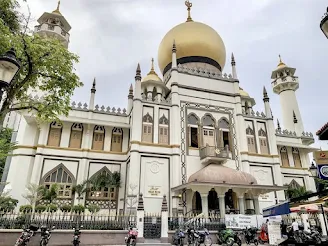 |
| Sultan Mosque (Masjid Sultan) |
Many pilgrims worked in Singapore to earn money for their passage although some never travelled to Makkah and they chose to settle down in Singapore. Baghdad Street, and the lower end of Bussorah Street used to be known as Kampong Tembaga or Copper Village as there were coppersmiths plying their trade there. The coppersmiths were mainly Chinese, so Bussorah Street was in fact home to people of various races.
Now, Bussorah Street has a mixture of upmarket middle eastern restaurants as well as delicious and affordable eateries and cafes. There are Middle Eastern, Malay and Indonesian eateries surrounding Bussorah Street. Well, there is a also a Japanese restaurant right in front of the mosque. During the evening, many restaurants there have alfresco style of dining, if it does not rain.
The original Sultan Mosque was a single level brick structure that was built between 1824 and 1826. But a century later as the congregation grew, it was demolished, and the present building was commissioned in 1924. The mosque was designed by Irish architect Denis Santry of Swan and MacLaren in the Indo-Saracenic style, with distinctive gold-coloured domes and minarets. Minarets are towers used for the call of prayers five times each day by a muezzin or crier, though nowadays recorded speakers are used instead.
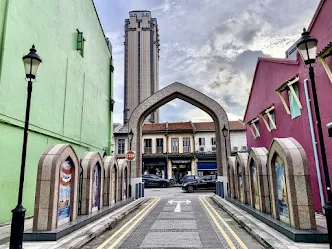 |
| Muscat Street. 'Batman' Building in the background. |
A Sleepy Kiwi Hostel is along Bussorah Street too, near Sultan Mosque, great for backpackers wanting a unique laid-back atmosphere in a traditional conservation area, surrounded by many eateries. Though this hostel has since been turned into modern capsule hostel located just next to tourism board visitor centre.
There are many shops that sell carpets and textiles, and silk (mostly along Arab Street and the nearby Jalan Sultan), traditional clothing, scarfs, jewellery, souvenirs, bookstores, rattan baskets, etc. You can even find Little Shophouse Peranakan store and teddy-bear shop there!
And once you are done with your wandering and browsing you can tuck in biryani,
roti prata or
murtabak at century old Zam Zam or Victory restaurants along North Bridge Road with what else but
teh tarik. Or perhaps try a popular Malay/ Indonesian Sumatran dish called
nasi padang.
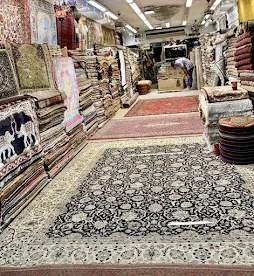 |
| Carpet store along Arab Street |
Some popular nasi padang restaurants or cafes in Kampong Glam include Sabar Menanti, Mirhimah and Warong Nasi Pariaman, all along North Bridge Road. And Rumah Makan Minang at the junction of Muscat Street and Kandahar Street.
One of the centrepieces of nasi padang dish is beef rendang, a slow-cooked dish of beef mix with spices and coconut which originated from the Minangkabau people but has also been adapted in other regions. Look at the architecture of Rumah Makan Minang from the entrance gate of the
Malay Heritage Centre along Kandahar Street and you will see the distinctive shape of the Minangkabau roof. Padang is the capital of Indonesia's West Sumatra, and Minangkabau cuisine generally is called Padang cuisine, hence the name, nasi padang.
Do you know that the first president of Singapore, the late Mr. Yusuf Ishak came from the Minangkabau descent? The ubiquitous face on a Singapore dollar bill belongs to him.
 |
Nasi Padang restaurant along North Bridge Rd
|
Another traditional Malay kampong style meal place is Hajah Maimunah along Jalan Pisang, where you order rice with few dishes such as grilled chicken, beef rendang,
ikan bakar,
urap,
sambal telur, and my all-time favourite
lemak siput. They also serve nasi ambeng. Hajah Maimunah Restaurant is listed in Michelin Bib Gourmand.
You will see long snaking queue outside the restaurant especially during lunch. Hajah Maimunah have another outlet along Joo Chiat Road near
Geylang Serai. Interesting some of streets off North Bridge Road are named after fruit trees such as pisang (banana), pinang (betel nut palm) and kledek (sweet potato).
Further down along Beach Road (in-between
Haji Lane and Arab Street) you can find many Chinese coffee-shops with the Blanco Court Prawn Mee coffee shop a lunch-time favourite for those who crave for noodles. So Kampong Glam is indeed home to many cuisines, not just restricted to middle eastern, Malay, Indonesian and Indian cuisines. Cafes or restaurants serving Italian and Swedish cuisines have also sprung up along Arab Street. And of course, the colourful Haji Lane is home to many western cuisines as well.
Beach Road is historically a shoreline where many
sampans used to ply, and it is thought that Raffles landed near there along the Rochor River instead of along Singapore River where Raffles statue is standing. Near Beach Road is also where the original
satay club used to be. Satay is barbecued meat on stick, smoked over charcoal, used to be sold by itinerant hawkers on the streets.
The once Sultan's Palace, Istana Kampong Glam is now Malay Heritage Centre, as the name implies is a centre or museum with a good collection of artifacts and articles about the history and heritage of the Malays in Singapore and the region. It features galleries that recount the stories of various ethnic communities and their contribution to Singapore's history including significant figures like Yusof bin Ishak, the first President of Singapore.
 |
| Malay Heritage Centre/ Istana Kampong Glam |
Entry is free for local residents though foreign visitors have to pay a $6. Seniors pay half. The palace is yellow in colour as yellow is the colour of royalty for the Malay kingdom.
The palace is actually quite small and is mostly wooden in construction in comparison to many royal castles or
chateaus elsewhere, as Singapore was poor in the early 19th century. The vast wall compound was known as Kota Raja or the Royal Citadel. The palace was probably designed by pioneer colonial architect George Coleman in a combination of Palladian and Malay style, but this cannot be verified.
George Coleman was Raffles consultant on the first Town Plan. He designed the Old Parliament House, now the Arts House, near Singapore River, which bore some resemblance in the architectural style. Sultan Hussein Shah's never lived in the palace. He died in Malacca. The Istana was built for Sultan Ali, his son.
The Istana along Orchard Road, the official residence of the presidents here, which is the former governors house is much larger and grander in scale. There is a small but lovely spice garden near the visitor centre cum souvenir store showing how Singapore was once upon a time had many spice plantations and fruit orchards. By the way, the upmarket shopping belt Orchard Road was once a nutmeg plantation!
The word Glam is derived from
Gelam trees which used to grow here in olden days. Kampong is the malay word for village. You can still find a few paperbark Gelam trees, a species of tea-tree or eucalyptus at a small park along Kandahar Street. The famous local medicated oil products such as Tiger Balm and Axe Oil ointment has Gelam or cajaputi (kayu putih) oil as one of its ingredients! Well, flu-like symptoms can supposedly be reduced when using gelam. The oil can also be used for toothache, earache and headache relief.
 |
| Sarong Kebaya and batik store |
Apparently the gelam (melaleuca cajaputi) leaves have anti-bacterial, anti-inflammatory and pain-relieving properties. The leaves can also soothe burns. Other supposedly benefits of gelam plant is it helps ease the airways if you have asthma. Imagine in the olden days, people use available local plants with medicinal properties to treat many ailments. We know and learn that many plants have curative power. After all plants existed long before mankind.
In Australia the tea-tree oil is popular too. The paperbarks are used to caulk boats in the olden days. So, very useful tree indeed. Gelam trees still thrive well here. You can find clusters of gelam trees at
Pasir Ris Park, at
Jurong Lake Gardens and at Singapore Botanic Gardens in particular at the Foliage and Healing Gardens. It is actually a common tree in Singapore especially along the shores, though it is not native to Singapore. Pick up some fallen leaves on the ground, crush them and smell the similar aroma or fragrance.
 |
| Sultan Arts Village at Sultan Gate |
At the spice garden at the Malay Heritage Centre you can find
inai or henna plant which is commonly used as a natural dye. Among other things the leaves of inai plant can be used to relieve coughs in illnesses such as bronchitis. Other plants samples you can find at the garden include clove, wild peppers and nutmeg. Actually, you can find wild peppers along many roadsides here.
Clove, peppers and nutmeg were once planted and traded as economic cash crops in Singapore during the 1800s before Singapore became a modern trading post and financial centre. The little spice garden also has samples of the common tropical fruits' trees such as
durian, the king of fruit of South-East Asia some likened to smelly socks, rambutan (the reddish hairy little fruit), ciku, and mango. One interesting plant sample is
tongkat ali or longjack, purportedly useful for male reproductive system. Apparently tongkat ali is still sold in malay traditional medicinal shop.
 |
| An early shophouse along Bussorah Street |
There are many perfume stores at Kampong Glam. If you are looking for some inexpensive perfumes that you can mix yourself head to Jamal Kazura perfume store. A small bottle of perfume cost $10. They have few outlets at Kampong Glam.
There are many things you can do and see at Kampong Glam. And if you are looking for something artful and bohemian, head to hip and trendy Haji Lane where you can find an eclectic mix of cool boutique, designer and yoga accessories shops mixed with cool looking cafes and food and beverage outlets. For those looking for some watering holes, there are many bars along Haji Lane, especially towards the second half of the narrow lane towards Beach Road.
 |
| Colourful Haji Lane |
There are a few Spanish-theme bars with its huge mayan-ish
wall arts. You can find some nice shirts for $10. Or just stroll along the narrow street and enjoy the colourful shophouses and bohemian atmosphere. If you start your stroll from the North Bridge end where most it would be most likely be the starting point, you will not miss the bright orange 'I AM' sculpture designed after the famous I AM of Armsterdam. (An update, the sign is no longer there as the cafe has changed)
Haji Lane is a selfie street with its colourful
streets arts and wall murals splashed on the walls of the shophouses. This street, albeit a little touristy, can rival many street arts around the world. Do check out also two parallel streets to it, in-between Baghdad Street and Muscat Street, as well as Sultan Arts Village at Sultan Gate (peep behind a pottery clay shop), and you will discover the whole of Kampong Glam is indeed full of streets arts. Now who says Singapore is boring?
Incidentally Baghdad Street was once Intan Street or Kampong Intan (Diamond Village) because there were many Banjaree diamond traders and jewellers who conducted jewellery business in the area. Check out the huge wall art of 'diamonds' along a narrow alley off Baghdad Street, next to the % Arabica Cafe.
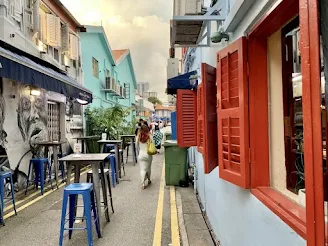 |
| Haji Lane |
If you are looking for old school malay kueh or snacks at Kampong Glam you certainly can find them. You can get
pulut lemper for $6 for three pieces at Ratu Lemper along Baghdad Street.
Pulut is glutinous rice. The glutinous rice is wrapped in banana leaves, and they are layered with either
ayam original (original chicken),
ayam pedas (spicy chicken),
ayam extra pedas (extra spicy chicken) or
rendang sapi (beef rendang).
Rendang dish is one of the all-time favourites among Malays and Indonesians. You can find rendang at many nasi padang cafes at Kampong Glam as already mentioned above. And there is a unique Malaysian shop called Agrobazaar that sells many things like jackfruit crackers, rojak paste, traditional coffee, pre-prepared spices, even fresh
durians. Of course, Kampong Glam is not the only place to try Malay dishes.
Geylang Serai, closer to the east, is actually the place where you can find a larger concentration of Malay food. But that is another post.
Do go to Kampong Glam from late morning onwards as most shops will open by then. A unique place for a late morning or late afternoon stroll and evening meal with great photo shoots opportunities.
 |
| Nasi Padang |
Major events at Kampong Glam are the Ramadan FoodFest and Culture Fest. There are monthly events such as PlayStreets on first weekend (Saturday and Sunday from 3pm to 7pm), Art Street Market on the second weekend (Friday 7pm to 11pm, Saturday and Sunday 3pm to 11pm), Neighbourhood Sketches on the third weekend (Friday and Saturday 8pm to 9pm) and Pasar Lambak on the final weekend (Friday 7pm to 11pm, Saturday and Sunday 3pm to 11pm). An update, some of these events may no longer be there, but new events crop up now and then.
During the month of Ramadan there is bazaar in the vicinity in front of the mosque and Muscat Street. It is usually held in the late afternoon till just before the breaking of fast at sunset. There are good selection of stalls selling various food for the breaking of fast. There is a bigger Hari Raya bazaar at Geylang Serai complete with streetlight-up that opens till late during Ramadan if you want to soak up in the festive mood. Hari Raya Puasa or Hari Raya Aidil Fitri marks the end of the month-long Ramadan and is not a Malay or Islamic New Year. Hari Raya Puasa actually falls on the 10th month of the Islamic calendar.
Muscat Street was named in 1909 after the capital of Oman. Muscat Street, which is popular with tourists taking photos below it, especially the one closer to Kandahar Street with the Sultan Mosque in the backgroung, was jointly redeveloped in 2012 by Singapore and Oman. The arches reflect Kampong Glam's role as a hub for Arab traders during Singapore's early history. The murals symbolise the maritime and trade connection between Singapore and Oman which have continued to this day.
Closest MRT station to Kampong Glam is Bugis Station, Exit B. Look out for the imposing building called Parkview Square which is likened to the Gotham City's Batman's Building and Kampong Glam is not too far away there. If you can see the golden domes of the mosque, you have reached the place.
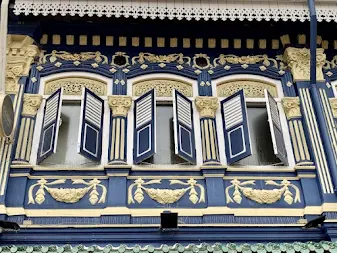 |
| Festoon or swag at shophouses at Bussorah St. |
Parkview Square also known as the Batman Building or the Gotham City of Singapore is an attraction by itself. Sneak a peek inside and outside and there are some artistic treasures with sculptures from famous artist such as Salvador Dali, Fernando Botero and Roberto Barni. The world's famous bar, Atlas Bar, is inside Parkview Square.
The design of the Atlas Bar is mesmerising taking its inspiration form the movie the Greats Gatsby. Inside the buildings at the four corners are Salvador Dali's sculptures. Outside the building in the courtyard, there is a sculpture of 'dressed woman' by famous Colombian sculptor, Fernando Botero. You may have seen both Dali and Botero sculptures in other parts of Singapore as well. There is also a museum with Chinese arts at Level 3. You can see the tall Batman Building in the background of the third photo above.
 |
| Rich and Good Cake Shop |
Look out for the simple looking Rich and Good Cakeshop, along Kandahar Street for its mouth-watering swiss rolls. Flavours include mango, kaya, strawberries, velvet, chocolate and
durian. Durian is that 'sweet'-smelling fruit that we all love. Kaya is a local coconut-based pandan-flavoured jam. It's a take-out only cake shop. A box of swiss-roll is about $10. They have an outlet at Jewel Changi Airport.
A visit to Kampong Glam would not be complete without tasting the sweet teh-tarek (teh tarik) at the Bhai Sarbat tea stall along Baghdad Street. They advertised themselves as the Best Chai Shop in Singapore. Teh-tarek comes in other flavours too, like teh halia (ginger tea). Just like Rich and Good Cake Shop with its queue, expect snaking queue at this teh-tarik shop as well especially during teatime. The
teh-tarik will only set you back at $1.80.
 |
| Henna hand tattoo |
And if you are into jazz check out the iconic Blue Jaz Bar along Bali Lane. And a Japanese coffee chains
% Arabica and 2050 Coffee along Baghdad Street and Beach Road respectively. Kampong Glam is indeed a very chic, cool and refreshing place. So, you can find jazz, arts, Swiss-rolls, delicious artisanal bakeries and cakes such as Konditori and Julie's Bake, great coffee, gourmet ice-cream, refreshing teh-tarek all in one place. And there's a cat cafe too.
[An update: Agrobazaar is no longer at Kampong Glam, and Little Shophouse has shifted to the nearby Golden Landmark Building, level 3. The I AM cafe is also no longer there and has been replaced by another cafe which sells the popular Malay snack, putu piring from the famous Haig Road Putu Piring.]

















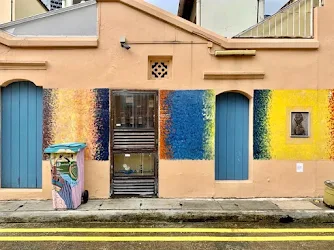
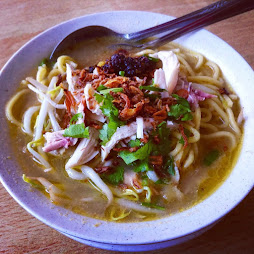


Thanks for your share about Kampong Lam. I was know more about Singapore via your article.
ReplyDelete